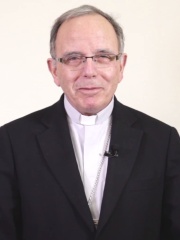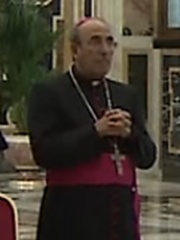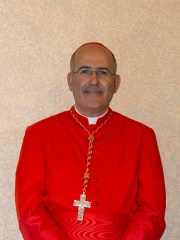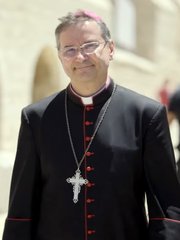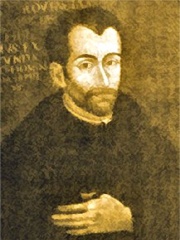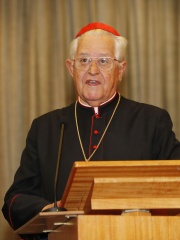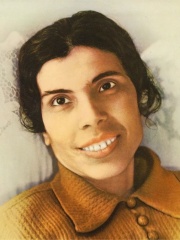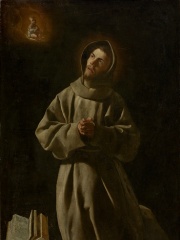

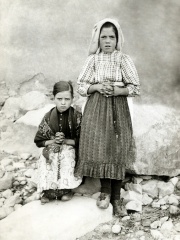

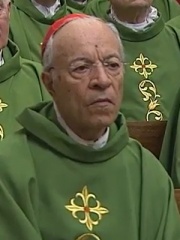
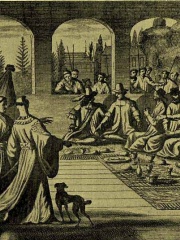
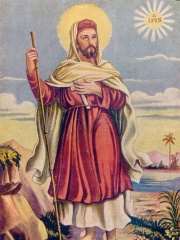
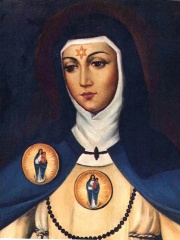
The Most Famous
RELIGIOUS FIGURES from Portugal
This page contains a list of the greatest Portuguese Religious Figures. The pantheon dataset contains 3,187 Religious Figures, 22 of which were born in Portugal. This makes Portugal the birth place of the 25th most number of Religious Figures behind Czechia, and Austria.
Top 10
The following people are considered by Pantheon to be the top 10 most legendary Portuguese Religious Figures of all time. This list of famous Portuguese Religious Figures is sorted by HPI (Historical Popularity Index), a metric that aggregates information on a biography's online popularity. Visit the rankings page to view the entire list of Portuguese Religious Figures.

1. Anthony of Padua (1195 - 1231)
With an HPI of 82.94, Anthony of Padua is the most famous Portuguese Religious Figure. His biography has been translated into 70 different languages on wikipedia.
Anthony of Padua, OFM, or Anthony of Lisbon; born Fernando Martins de Bulhões (15 August 1195 – 13 June 1231) was a Portuguese Catholic priest and member of the Order of Friars Minor. Anthony was born to and raised by a wealthy family in Lisbon, Portugal, and died in Padua, Italy. Noted by his contemporaries for his powerful preaching, expert knowledge of scripture, and undying love and devotion to the poor and the sick, he was one of the most quickly canonized saints in church history, being canonized less than a year after his death. He was proclaimed a Doctor of the Church by Pope Pius XII on 16 January 1946.

2. Pope John XXI (1215 - 1277)
With an HPI of 77.63, Pope John XXI is the 2nd most famous Portuguese Religious Figure. His biography has been translated into 67 different languages.
Pope John XXI (Latin: Ioannes XXI, Italian: Giovanni XXI, Portuguese: João XXI; c. 1215 – 20 May 1277), born Pedro Julião (Latin: Petrus Iulianus), was head of the Catholic Church and ruler of the Papal States from 8 September 1276 to his death in May 1277. He is the only ethnically Portuguese pope in history. He is sometimes identified with the logician and herbalist Peter of Spain (Latin: Petrus Hispanus; Portuguese: Pedro Hispano), which would make him the only pope to have been a physician.

3. Sister Lúcia (1907 - 2005)
With an HPI of 72.14, Sister Lúcia is the 3rd most famous Portuguese Religious Figure. Her biography has been translated into 30 different languages.
Lúcia de Jesus Rosa dos Santos, OCD, (28 March 1907 – 13 February 2005) also known as Lúcia of Fátima and by her religious name Maria Lúcia of Jesus and of the Immaculate Heart, was a Discalced Carmelite from Portugal. Sister Lúcia and her cousins Francisco and Jacinta Marto claimed to have witnessed the apparitions of Our Lady of Fátima in 1917. Her beatification process was opened in 2017. In 2023, she was declared venerable. Born in 1907 to landowning peasants on the outskirts of Fátima, Portugal, Lúcia came to prominence in 1917 as the oldest of the three child seers of the apparitions Our Lady of Fátima. This involved her and her two cousins, Francisco and Jacinta Marto, claiming to see the Virgin Mary in six apparitions. These apparitions sparked major interest, concluding with what is called the Miracle of the Sun being witnessed by tens of thousands in October of that year. After Francisco and Jacinta both died during the Spanish Flu, Lúcia remained the only living seer for the rest of her life. In 1921, Lúcia became a religious sister in Spain and eventually a Discalced Carmelite nun in 1948. She wrote numerous memoirs about her experiences at Fátima and numerous letters concerning the events. She also transcribed the Three Secrets of Fátima, the last of which was only published by the Vatican in 2000. Sister Lúcia died on 13 February 2005 at the Carmelite convent of Santa Teresa in Coimbra.

4. John of God (1495 - 1550)
With an HPI of 71.02, John of God is the 4th most famous Portuguese Religious Figure. His biography has been translated into 29 different languages.
John of God, O.H. (Portuguese: João de Deus; Spanish: Juan de Dios; born João Duarte Cidade [ˈʒwɐ̃w̃ duˈwaɾ.t siˈða.ðɨ]; March 8, 1495 – March 8, 1550) was a Portuguese soldier turned healthcare worker in Spain, whose followers later formed the Brothers Hospitallers of Saint John of God, a Catholic religious institute dedicated to the care of the poor, sick and those with mental disorders. Cidade was canonized by Pope Alexander VIII and is considered one of the leading religious figures in the history of the Iberian Peninsula.
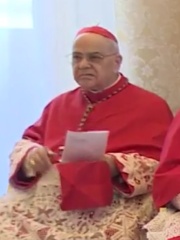
5. José Saraiva Martins (b. 1932)
With an HPI of 65.91, José Saraiva Martins is the 5th most famous Portuguese Religious Figure. His biography has been translated into 23 different languages.
José Saraiva Martins, C.M.F. GCC (born 6 January 1932) is a Portuguese cardinal of the Catholic Church. He was prefect of the Congregation for the Causes of Saints from 1998 to 2008.

6. Manuel Monteiro de Castro (b. 1938)
With an HPI of 64.15, Manuel Monteiro de Castro is the 6th most famous Portuguese Religious Figure. His biography has been translated into 22 different languages.
Manuel Monteiro de Castro (born 29 March 1938) is a Portuguese prelate of the Catholic Church who worked in the diplomatic service of the Holy See from 1967 to 2009, with the rank of archbishop and the title of nuncio from 1985. His assignments as nuncio included the Caribbean, South Africa, Central America, and Spain. He ended his career in senior positions in the Roman Curia from 2009 to 2013. He was made a cardinal in 2012.

7. Cristóvão Ferreira (1580 - 1650)
With an HPI of 64.05, Cristóvão Ferreira is the 7th most famous Portuguese Religious Figure. His biography has been translated into 15 different languages.
Cristóvão Ferreira (c. 1580–1650) was a Portuguese Catholic priest and Jesuit missionary who committed apostasy after being captured and tortured during the anti-Christian purges in 17th-century Japan. During the Tokugawa shogunate, Christian missionaries and their Japanese followers were persecuted, arrested and executed. Authorities were concerned that the religion was making followers loyal to Christian nations rather than the Emperor or the shogunate. After Ferreira had renounced his faith, he remained in Japan for the rest of his life. He became known as one of the "fallen priests" who assisted Japanese authorities with their knowledge of Western philosophies and sciences.

8. John de Britto (1647 - 1693)
With an HPI of 63.91, John de Britto is the 8th most famous Portuguese Religious Figure. His biography has been translated into 17 different languages.
John de Britto, SJ (also Brito; Portuguese: João de Brito; also known as Arul Anandar; 1 March 1647 – 4 February 1693) was a Portuguese Jesuit missionary and an evangelist, often called "the Portuguese St. Francis Xavier" by Indian Catholics. He is also called "the John the Baptist of India."

9. Beatrice of Silva (1424 - 1492)
With an HPI of 63.62, Beatrice of Silva is the 9th most famous Portuguese Religious Figure. Her biography has been translated into 15 different languages.
Beatrice of Silva (Campo Maior, Portugal ca. 1424 – Toledo, Castile, 16 August 1492), born Beatriz de Menezes da Silva, was a Portuguese noblewoman who became the foundress of the monastic Order of the Immaculate Conception (known as the Conceptionists). Amadeus of Portugal's younger sister, she is honored as a saint by the Roman Catholic Church.
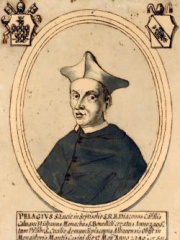
10. Pelagio Galvani (1165 - 1230)
With an HPI of 62.57, Pelagio Galvani is the 10th most famous Portuguese Religious Figure. His biography has been translated into 16 different languages.
Pelagio Galvani (c. 1165 – 30 January 1230, Portuguese: Paio Galvão Latin: Pelagius) was a Leonese cardinal, and canon lawyer. He became a papal legate and leader of the Fifth Crusade. Born at Guimarães, his early life is little known. It is repeatedly claimed that he entered the Order of Saint Benedict but this is not proven. Pope Innocent III created him cardinal-deacon of Santa Lucia in Septisolio around 1206. Later, he was promoted to the rank of cardinal-priest of S. Cecilia (probably on 2 April 1211), and finally opted for the suburbicarian see of Albano in the spring of 1213. He subscribed the papal bulls between 4 May 1207 and 26 January 1230. He was sent on a diplomatic mission to Constantinople in 1213. During this two-year mission he attempted to close Orthodox churches and imprison the clergy, but this caused such domestic upset that Henry of Flanders, the Latin Emperor of Constantinople, reversed his actions which had caused the "tempest which held the city of Constantine in its grip", as noted a contemporary historian. Three years later he was elected Latin Patriarch of Antioch but his election was not ratified by the Holy See. He was dispatched in 1218 by Pope Honorius III to lead the Fifth Crusade at Damietta in Egypt, and made a poor strategic decision in turning down favourable peace offers made by the sultan al-Kamil. During his absence, the see of Albano was administer by Thomas of Capua. He became dean of the Sacred College of Cardinals at the election to the papacy of Cardinal Ugolino Conti, who became Pope Gregory IX, on 19 March 1227. He was one of the leaders of the papal army in 1229–1230 during the War of the Keys against the Emperor Frederick II. He died at Monte Cassino and was buried there.
People
Pantheon has 22 people classified as Portuguese religious figures born between 540 and 1973. Of these 22, 6 (27.27%) of them are still alive today. The most famous living Portuguese religious figures include José Saraiva Martins, Manuel Monteiro de Castro, and Manuel Clemente. The most famous deceased Portuguese religious figures include Anthony of Padua, Pope John XXI, and Sister Lúcia. As of April 2024, 1 new Portuguese religious figures have been added to Pantheon including Américo Aguiar.
Living Portuguese Religious Figures
Go to all RankingsJosé Saraiva Martins
1932 - Present
HPI: 65.91
Manuel Monteiro de Castro
1938 - Present
HPI: 64.15
Manuel Clemente
1948 - Present
HPI: 61.41
António Marto
1947 - Present
HPI: 61.20
José Tolentino de Mendonça
1965 - Present
HPI: 59.89
Américo Aguiar
1973 - Present
HPI: 52.04
Deceased Portuguese Religious Figures
Go to all RankingsAnthony of Padua
1195 - 1231
HPI: 82.94
Pope John XXI
1215 - 1277
HPI: 77.63
Sister Lúcia
1907 - 2005
HPI: 72.14
John of God
1495 - 1550
HPI: 71.02
Cristóvão Ferreira
1580 - 1650
HPI: 64.05
John de Britto
1647 - 1693
HPI: 63.91
Beatrice of Silva
1424 - 1492
HPI: 63.62
Pelagio Galvani
1165 - 1230
HPI: 62.57
António de Andrade
1580 - 1634
HPI: 61.74
José Policarpo
1936 - 2014
HPI: 61.50
Alexandrina of Balazar
1904 - 1955
HPI: 61.33
James of Portugal
1433 - 1459
HPI: 60.45
Newly Added Portuguese Religious Figures (2025)
Go to all RankingsOverlapping Lives
Which Religious Figures were alive at the same time? This visualization shows the lifespans of the 5 most globally memorable Religious Figures since 1700.

